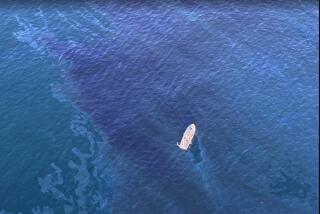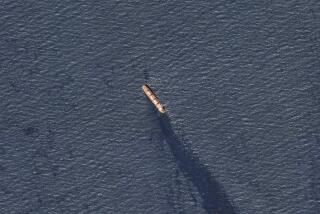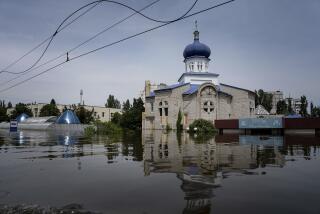Pipelines Bombed to Halt Spill : No Need to Rush Into Ground Conflict, Cheney Says : Gulf War: U.S. jets target oil-flow regulators in Kuwait. ‘I think that we’ve been successful, but only time will tell,’ Schwarzkopf says. The slick spreads into Saudi waters.
DHAHRAN, Saudi Arabia — In a dramatic bid to check a gush of oil into Persian Gulf waters, U.S. warplanes swept into Kuwait and dropped precision glider bombs on two inland pipeline devices that direct crude toward the offshore Sea Island loading station, U.S. military officials said Sunday.
They said it would take a full day to determine whether the nighttime raid by F-111 fighter-bombers on key parts of Kuwait’s premier oil facility was successful.
“I think that we’ve been successful, but only time will tell,” Gen. H. Norman Schwarzkopf, commander of allied forces in the Persian Gulf, told reporters in Riyadh.
U.S. officials have accused Iraq of releasing millions of barrels of Kuwaiti crude into the gulf, draining moored oil tankers and opening an offshore pipeline. Baghdad claims the oil spill is the result of U.S.-led bombing raids on Kuwait.
Oil was said to be surging into the gulf at a rate of more than 1.2 million barrels a day--more than four times the amount discharged during the entire Exxon Valdez oil disaster.
By Sunday, the slow-moving slick had widened to at least 350 square miles and crept into Saudi Arabian waters off Ras al Mishab, about 30 miles south of the Kuwaiti border. Winds kept most of it two to three miles offshore, and a decidedly uphill effort was under way to lessen the impact on the gulf’s already fragile marine life.
“It is apparent that Saddam Hussein has chosen not only to threaten and destroy the resources of this generation, but also the resources of the future generation,” said Abdulbar Gain, president of Saudi Arabia’s Meteorology and Environmental Protection Agency. “An oil spill of this magnitude is completely unimaginable. It is catastrophic in terms of the possible damage it might cause.”
Schwarzkopf said U.S. intelligence detected the spill last Thursday, observing first that five tankers moored at the Kuwaiti oil complex of Al Ahmadi were conspicuously lighter in the water, and then that a black patch was moving from an offshore buoy at the Sea Island supertanker loading terminal, located about eight miles offshore.
Hasty briefings with military and oil experts followed, and U.S. officials were counseled to attack the spill in two ways: Set fire to the source, the Sea Island terminal, to burn off any crude moving through its tanks and pipes, and launch an air strike designed to halt the flow of new oil toward the gulf facility.
Oil consultants had advised that the flow out of storage tanks at Al Ahmadi, from which the pipeline stemmed, could be checked by bombing a pair of manifolds at a facility about five miles inland. Oil-field pipes feed into the manifolds, which then move the crude under pressure into the storage tanks, Schwarzkopf said. Bombing the manifolds thus would deprive the system of any fresh crude.
The first step was accomplished Friday night through what apparently was a piece of military serendipity. A small Iraqi patrol boat confronted a U.S. Navy ship near the offshore facility. The Navy ship opened fire and, in the process--Schwarzkopf called it a “circumstantial happening”--the Sea Island terminal was set ablaze.
The second step began at 10:30 p.m. Saturday with the commencement of the F-111 attack. The warplanes unleashed a pair of GBU-15 guided precision munitions that slammed precisely into both manifolds, according to indications from video cameras mounted in the noses of the weapons.
Schwarzkopf said the attack met with no opposing fire from Iraqi troops.
Videotape of a fire on the oil buoy near the source of the spill showed that after the attack what had been billowing clouds of black smoke had lightened to gray, and that the flames were dwindling. Schwarzkopf said that the pictures may indicate that oil still in the pipeline before the attack is burning itself out.
He said it would take about 24 hours for the oil in 13 miles of pipeline between Sea Island and the inland manifolds to burn out, he said. If the fire is still burning after that, he said, U.S. officials will know their mission had failed.
“We’re not going to know anything for at least 24 hours,” Schwarzkopf said. “Hopefully, we’ll then see a great diminishment. If not, we’ll go back to the engineers and see if there’s anything else we can do.”
Schwarzkopf said the slick is 35 miles long and 10 miles wide, but U.S. pilots flying over the area said it stretched at least 50 miles long and 20 miles wide.
He said that U.S. military and environmental consultants had given wide-ranging and sometimes conflicting advice about likely damage from the oil spill, and he stressed that the military remains committed to limiting further damage to Kuwaiti oil facilities.
“We’re not in the business of destroying Kuwait while we’re liberating Kuwait,” he said.
There were also reports that a second spill was flowing from a damaged oil tank at Khafji, just south of the Saudi-Kuwaiti border. An official at Saudi Aramco said that spill was two miles long and 100 to 200 yards wide, lying directly along the coast. Though authorities said it is not clear what started the spill, there have been reports of Iraqi artillery fire damaging at least one oil storage tank at Khafji. Other officials said they believe an offshoot of the main slick is responsible for oil damage in the abandoned coastal city.
Saudi officials said Sunday that they have established a 24-hour-a-day spill management office to coordinate what is rapidly becoming an international effort to manage the disaster. Saudi Aramco, the company that manages the majority of Saudi Arabia’s oil production, also has commissioned an oil spill response team, and an interagency team of U.S. environmental experts is scheduled to arrive today. Saudi officials, already stocked with large quantities of spill-fighting equipment, sent out international requests for more.
Authorities said they felt confident they would be able to protect major industrial facilities from the oncoming petroleum assault.
At Jubayl, the huge petrochemical and industrial center that lies along the northeastern coast of Saudi Arabia, workers reportedly were laying double rows of rubber booms in the sea to hold back the oil slick from the intakes on petrochemical plant cooling lines and two giant water desalination plants that supply about 60% of Saudi Arabia’s water.
The slick, moving southeast at the rate of about 10 miles a day, was not expected to reach Jubayl until Tuesday.
Farther down the coast, at Al Khubar, workers were to begin laying booms today around another major water desalination plant.
On Tehran Radio, monitored in Jordan on Sunday, the head of Iran’s Environmental Protection Organization said that country is using floating booms to help shield Iran’s long coastline on the gulf’s eastern shore from the spill.
Iranian officials said they gained extensive experience in controlling oil spills during Iran’s own eight-year war with Iraq, which caused the last great gulf oil spill in 1983 when Iraqi warplanes blew up an offshore Iranian well. That spill fouled shorelines as far away as Qatar’s north coast before Iran, with the aid of foreign specialists, managed to shut down the leaking well.
Oil industry experts said chances are good that the air strike on the manifolds will work, but they cautioned that finding other ways to dump oil into the gulf would not prove difficult for Iraqi forces.
Joseph Story, a McLean, Va., oil consultant and former Aramco executive with long Middle East experience, said any interruption of the system of pipelines that converge at the oil terminal manifold described by Schwarzkopf would halt the flow of crude oil into gulf waters. But he added that there are myriad other ways to dump oil into the gulf, including filling up Iraqi tankers and simply draining them into the waterway.
Amy Stolls, editor of the Massachusetts-based Oil Spill Intelligence Report, praised the manifold bombing as “one of the best solutions possible.”
“If they cut off the pumps, then the oil will stop flowing,” she said. “Many of the wells in the gulf are low pressure and need the pumps to bring the oil up.”
But, she noted: “Hussein has control of quite a few fields up there, and he could just open more valves.”
Schwarzkopf admitted that the air strike might not work, and that it also is “entirely conceivable” that Iraq could cause further damage at other Kuwaiti oil facilities.
“I am not guaranteeing anybody that this fire is going to go out,” he said. “All I am showing you is what we have done to date to try to use our military power to solve this very, very difficult problem, and I am trying to show you that we tried to do it in such a way that we are not out there destroying the entire economy of Kuwait by doing it.”
He rejected an assertion that the environmental consequences of the spill call into question the U.S. military initiative in the gulf.
“I’m a lover of the environment,” he said, “but I think some great man once said there are some things worth fighting for, and I believe that also.”
Times staff writer Donald Woutat in Detroit contributed to this report.
NOTABLE OIL SPILLS
The Exxon Valdez disaster of March, 1989, was the worst in U.S. history. But when ranked with other massive oil spills involving both shipping and well disasters, it falls to 19th out of the top 20, and ties with the wreck of the Juan A. Lavelleja, which dumped 11 million gallons of oil off Algeria in 1980. Here are the 20 worst oil spills in history: * June 3, 1979: Well spill in Bay of Campeche off coast of Mexico. 140 million gallons.
* Feb. 4, 1983: Well spill at Nowruz, Iran, that dumped oil into Persian Gulf. 80 million gallons.
* Aug. 6, 1978: Fire aboard Castillo de Bellver, off Cape Town, South Africa. 78.5 million gallons.
* March 16, 1978: Tanker Amoco Cadiz ran aground off coast of France. 68.7 million gallons.
* July 19, 1979: Collision of two ships off Trinidad and Tobago, Atlantic Empress and Aegean Captain. 48.8 million gallons.
* August, 1980: Leak at well No. D103, Libya. 42 million gallons.
* Aug. 2, 1979: Wreck of Atlantic Empress, Barbados. 41.5 million gallons.
* Feb. 23, 1980: Wreck of Irenes Serenade, Greece. 36.6 million gallons.
* Aug. 20, 1981: Leak at Kuwait National Petrol Tank, Kuwait. 31.2 million gallons.
* Nov. 15,, 1979: Wreck of Independence, Istanbul, Turkey. 28.9 million gallons.
* May 25, 1978: Leak at No. 126 well/pipe, Iran. 28 million gallons.
* July 6, 1979: Leak at British Petroleum storage tank, Nigeria. 23.9 million gallons.
* Aug. 15, 1985: Wreck of the Nova, Kharg Island, Persian Gulf. 21.4 million gallons.
* Dec. 11, 1978: Leak at BP-Shell fuel depot, Zimbabwe. 20 million gallons.
* Jan. 7, 1983: Wreck of Assimi, off Oman: 15.8 million gallons.
* June 12, 1978: Tohoku Oil Co., Japan: 15 million gallons.
* Dec. 31, 1978: Wreck of Andros Patria, Spain. 14.6 million gallons.
* Dec. 10, 1983: Wreck of Peracles, Qatar. 14 million gallons.
* Dec. 29, 1980: Wreck of Juan A. Lavalleja, Algeria: 11 million gallons.
* March, 1989: Wreck of Exxon Valdez, Alaska. 11 million gallons.
Source: Oil Spill Intelligence Report
More to Read
Sign up for Essential California
The most important California stories and recommendations in your inbox every morning.
You may occasionally receive promotional content from the Los Angeles Times.









